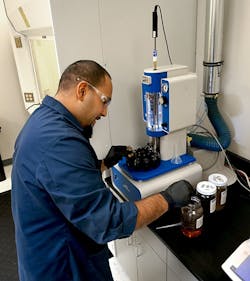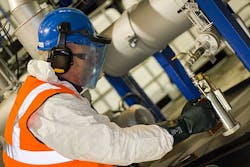Heat transfer fluids (HTFs) play a vital role in achieving and maintaining the proper temperature of many processes. Vendors of such fluids are finding an increasing need to help end users tackle operational issues such as workplace challenges caused by the pandemic. Meanwhile, emerging renewable-technology-related applications, like solar power concentrators, are creating new requirements for fluids.
COVID-19 has exacerbated existing issues such as changing worker demographics and lack of plant-based maintenance staff, and made vendor support services ever more important, notes Ed Cass, technology manager of Paratherm, King of Prussia, Pa., a division of Lubrizol.
“We continue to coach new maintenance managers, reliability managers and plant engineers who are inheriting responsibility for the heat transfer systems at their sites, often with little to no working knowledge of the systems. In recent years, we have participated in an increasing number of articles and webinars in an effort to help educate end users on best practices,” says Cass.
One of the best ways to increase productivity and reduce environmental impact in a facility using HTFs is by extending fluid lifespan. Here, proper selection, ongoing monitoring and maintenance are key, stresses Clive Jones, managing director of Global Heat Transfer, Stone, U.K.
“While the COVID-19 pandemic does not appear to have had a significant impact on the service we offer, users of heat transfer fluid and systems should ensure there are no lapses in service and change-out intervals. Regular maintenance and early detection of potential operating problems are essential to maintaining a safe working environment and satisfying insurance requirements,” counsels Rob Kennery, vice president of sales and marketing and general manager of Mokon, Buffalo, N.Y.
More Condition Monitoring
Regular fluid analysis, a service many vendors offer, can play a key role in enabling plants to spot and address factors that can reduce HTF efficiency. Paratherm notes its ISO-9001 laboratory has seen a steady year-on-year rise in samples as more process plants invest in reliability programs that increasingly include heat transfer systems (Figure 1). “Lean operating principles are also widely adopted, so robust preventative maintenance practices are more important than ever,” Cass notes.
Figure 1. Paratherm's ISO 9001 laboratory is analyzing ever more HTF samples. Source: Paratherm, a division of Lubrizol.
“The heat transfer market has traditionally been slow to reap the benefits of digitalization, but the pandemic became a catalyst for change. Condition-monitoring technology could revolutionize how businesses complete accurate fluid management in the future, both by bringing it into the digital age and by reducing time on site,” believes Jones of Global Heat Transfer.
“Investing in this equipment as part of a proactive maintenance program for thermal fluid management will help keep heat transfer systems running efficiently. It can also reduce the need for external engineers to visit the site regularly, because they can react to alerts on the remote condition-monitoring system and only assist when required,” he adds.
“Once it enters the system, thermal fluid is no longer visible, so degradation may go unnoticed until it negatively impacts production,” he explains. So, regular hot, live representative thermal fluid analysis is the optimum way to monitor fluid condition during operations. Global Heat Transfer’s analyses involve eleven parameters, aiding end users in evaluating fluid health to detect degradation early and take proactive steps to extend fluid lifespan.
Such steps could include thermal fluid filtration to remove contaminants, fluid reprocessing, and installing a light-ends-removal kit (LERK) for flash point management. However, this can be costly and, so, often begins only after an end user finds its fluid has fully degraded, Jones cautions. In such a situation, a manufacturer might already be increasing the process temperature to improve heat transfer and, in so doing, raising energy usage. “Soon after restarting the system, manufacturers will begin to see heat transfer efficiency improve and utility bills reduce as a result,” he adds.
As an example, Jones cites the far-too-frequent HTF replacement needed by a U.K.-based food supplier whose plant is one of the most advanced of its type in Europe. This increased production downtime and pushed costs well beyond those budgeted.
Thermal fluid analysis carried out by Global Heat Transfer found that light ends had formed, causing the HTF flashpoint to drop. The manufacturer tackled this by installing a LERK and implementing a proactive lifecycle maintenance program to regularly monitor fluid and plan interventions to extend fluid life.
“Monitoring of flash points is a continuous process and the LERK ensures safety at all times,” Jones stresses.
Such monitoring is one of the positive legacies of the COVID-19 pandemic as customers were forced to limit access to their plants by third parties, he notes. Today, Global Heat Transfer uses its Thermocare 24/7 cloud-based remote monitoring technology to carry out pre-site visits; its staff only appear in-person to carry out sampling (Figure 2).
Figure 2. Regularly sampling HTF is crucial for ensuring the fluid provides proper performance. Source: Global Heat Transfer.
The importance of early detection of potential HTF problems spurred Eastman Chemicals, Kingsport, Tenn., to develop Fluid Genius. The recently launched digital platform uses artificial intelligence, fluid-specific degradation kinetics, and key parameter thresholds to predict a fluid’s life expectancy and advise on how to extend this while avoiding unplanned shutdowns. It works for almost any organic HTF system.
Fluid Genius generates a condition score for the HTF in use and sends alerts about potential contamination to users. It also creates notifications and fluid trends, along with customizable recommendations about the need for specific actions, including system venting, inert-gas-blanketing system installation and inspection, fluid replacement, and implementation of side-stream filtration.
The patent-pending digital platform won a 2021 Vaaler Award. These biennial awards, bestowed by Chemical Processing, recognize products that promise to significantly improve the operations and economics of plants. See: “Four Products Win 2021 Vaaler Awards."
Other Emerging Trends
“Demand for fluid performance at the extremes is ever evolving,” notes Paratherm’s Cass. Developments in solar power have paved the way for new high-temperature HTFs while the extraction sciences industry is responsible for much of the low-temperature demands, he adds.
Global Heat Transfer designed its recently released Globaltherm Omnistore MS-600, a high-temperature — up to 600°C — molten-salt heat transfer medium, for concentrated solar power and thermal electricity storage applications.
Of course, these are not chemical processing applications. Mokon, for one, has seen little overall change in the specifications demanded of its HTFs by the chemical industry, notes Kennery.
Meanwhile, the increasing focus by industry on sustainability also is impacting HTFs, as exemplified by Global Heat Transfer’s launch of Globaltherm ECO, a fluid derived completely from vegetable extracts that reportedly provides efficient heat transfer over a broad temperature range.
“Fluid management and fluid reprocessing will become more relevant in a bid to make manufacturing more sustainable. Removing a waste product and reprocessing it for use in the same application, to extend the life of the product, or for use in another application or industry is also becoming more popular, says Jones of Global Heat Transfer.
Selection Factors
The choice of an HTF should consider a variety of factors such as regulations, chemical composition, and fluid properties such as stability and heat-transfer efficiency. Operating temperature, of course, is a key point.
“HTFs that can cover a very wide operating range are of great interest. In general, however, there is no ‘one size fits all’ fluid in the heat transfer world, but there are some fluids that cover a very wide range of temperatures. Fluids like these can simplify plant operations since a single product may be used for different plant processes with unique heating/cooling requirements,” Paratherm’s Cass explains.
However, no global standards or regulations exist for setting maximum temperature ratings for HTFs and many possible methods can determine thermal stability, he cautions.
For example, some fluid manufacturers set maximum fluid temperatures to coincide with a 5- or 10-year working life, while others may specify them based on laboratory ampoule testing, field performance or other criteria. Some HTF suppliers not specializing in heat transfer may set temperature ratings for competitive purposes with no “real” data to substantiate their claims, he warns.
“Since small temperature changes can have a big impact on fluid lifetime, it is critical that fluid manufacturers set maximum temperature ratings based on as many data points as possible. Data points should include laboratory testing as well as real-world performance evaluations. Operation at or near the stated maximum temperature should ensure that rapid degradation of the fluid is minimized,” he says.
Optimization goes beyond fluid selection, notes Kennery. Determining the best combination of HTF and heat transfer system for a specific use requires closely matching them to achieve the best performance and the best oxidation stability, he says, stressing Mokon’s abilities to do this. The company offers a free fluid analysis service to ensure the HTF is best suited for the intended application and the HTF and equipment are running at peak efficiency.
Other Tips
Prioritizing cost over performance in most cases turns out to be a bad decision, warns Cass. Here, he cites the example of a major chemical processor that was using a budget fluid for high-temperature operations. The system was well designed with nitrogen blanketing.
However, the budget fluid failed within months of start-up as low boilers accumulated from thermal stress. Performance of the fluid quickly deteriorated; mechanical symptoms such as pump cavitation, pressure relief, control failures and downtime ensued. The plant continued to drain and top off fluid to remove the low boilers before finally changing over to a high-performance product from Paratherm.
“The original fluid in this application was under-specified even though it was rated to 30°F higher than the operating setpoint. The plant spent more money replacing budget fluid over 12 months than they would have with the proper investment upfront. At high temperatures, fluid chemistry really matters, and matching fluid technologies to the operating conditions is critical. Working with a reputable fluid supplier who substantiates their claims will ensure getting the right fluid every time,” he concludes.
Thermal degradation is best managed by always ensuring proper flow rate and velocity through the heater, counsels Cass. “It is also critical that the plant follows all preventative maintenance schedules outlined by the equipment OEMs [original equipment manufacturers],” he emphasizes.
A plant can completely avoid another potential problem, oxidative degradation, by blanketing the system with an inert gas such as nitrogen. If this is not an option, the addition of a thermal buffer tank or a cold seal pot and proper bypass valve configuration on double drop leg expansion tanks can mitigate oxidation, says Cass.
A third common issue, contamination, is best managed by storing HTF containers indoors with sealed closures, and by using dedicated equipment when possible, he adds.
New Products
In November 2021, Mokon expanded its line of HTF systems with the addition of the HTF 400 Series. It is designed to maximize performance with fluid temperatures up to 400°F (204°C), offering customers a higher temperature range for lower-end process requirements.
For its part, Paratherm has launched Paratherm HT and HR, synthetics suitable for continuous performance up to 357°C (675°F); Paratherm GP and Paratherm GLT, which are formulated to outperform standard organic HTFs; five food-grade HTFs; and custom system cleaners.
Meanwhile, Global Heat Transfer, also introduced Globaltherm HF, which suits chemical processing as well as polymer, plastics and styrene applications, and bitumen production and storage. “This thermal fluid has a flash point of 276°C — the highest in the market,” notes Jones.
Seán Ottewell is Chemical Processing's editor at large. You can email him at [email protected].




